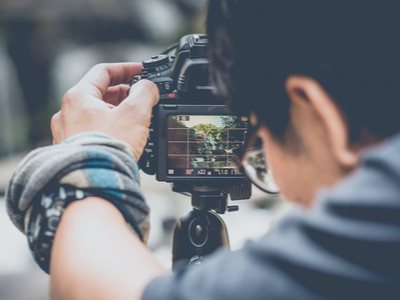We LOVE talking about our online casino slots real money games, but decided to take a look today at National Photography Month.
Photography has come a long way since the 1830s when the first portable camera obscrua was used to expose a pewter plate coated with bitumen to light. The image didn’t fade quickly and other advances followed including daguerreotypes, wet plates and emulsion followed. By the mid 1800s the base of modern photography had been laid and photographers would capture scenes, portraits and images for posterity.
Photography has the ability to communicate and document moments in time. By sharing photographs you are sharing an experience, a relationship or an adventure with others. The technology of today’s photographs is very different than it was for most of the history of photography but the phrase “a picture is as good as a thousand words” is as true today as it was in 1839.
Celebrate the social and creative uses of photography during the National Photography Month of May.
History of Photography
During the early years of photography, taking pictures was only for the very rich. The processes that were required to capture images involved expensive equipment and materials and a considerable amount of time for processing. In the 1880s George Eastman created a company called Kodak that made flexible roll film available so that the need to change the solid plates was eliminated.
Eastman invented a self-contained boxed camera that could be used for dozens of exposures. The camera had a small single lens with no focusing adjustment so the user could simply take pictures and then send the camera to the factory where the film would be developed and prints would be made. More people could own cameras and more people could get pictures taken by “professionals” who would travel around, offering their photography services on a photo-by-photo basis.
By the 1940s 35 mm film was cheap enough for most consumers to use. Polaroid cameras were introduced to give people the opportunity to print their photos within minutes of having taken them thanks to the Polaroid’s secret chemical process that developed film inside the camera.
The concept of a handheld-sized camera was the once believed to be in the realm of the world of espionage but today, anyone who has a smartphone has a camera as part of the phone hardware. Point and shoot cameras use digital media instead of film which are then stored on the phone or in the digital camera for later high-quality printing.
National Photography Month
In 1987, Congress recognized the role photography plays in modern society by designating May as National Photography Month. People around the world celebrate National Photography month with activities, photography contests, festivals and exhibits. It has become clear that, instead of diluting the art and science of photography, the public’s increased access to high-quality, powerful camera technology has resulted in more interest in photography as a profession and as a hobby than ever.
Today it’s easier than ever to take excellent photos in the time that it takes to whip your phone out of your bag or pocket. That doesn’t mean, however, that you don’t need to learn good techniques for taking good photos. Photographers are generally happy to pass one their tips and tricks for getting the most out of your camera. Some of those ideas include:
Camera Features
Learn your camera. Take some time to look up a tutorial about your camera online (YouTube has many) so you know what tools you have to work with. Not every camera/phone camera has all of these tools but most of today’s basic digital cameras and smartphone cameras have most, if not all of these features. You probably won’t remember to use them all on every photo but through practice you’ll become more familiar with many of these basic tools such as
- Zoom Feature – allows you to zoom in and out of an image/scene
- Viewfinder – a grid that appears on your viewing screen that helps you strategize the composition of your photo
- Focus – don’t rely on the auto-focus feature. Set it on manual and change it as needed for more interesting photographs
- Aperture – the aperture settle allows you to control the light in your images
- Color Balance – gauge the lighting to decide how you need to adjust your color balance settings so that the colors in the images that you are photographing come out right.
- Shutter Speed – adjusting your shutter speed may be a bit advanced but you can play with it to see what works best for you. Too slow a shutter speed and the images come out blurry but too fast and they come out dark.
- Manuel Mode – if you’re an amateur and just starting out you may not want to take your phone off the manual mode but as you become more proficient, you may want to start setting the modes to “sport”, “landscape,” “portrait,” and others so that you gain more control over your work
- Flash – try to stick to external light sources but you should learn when you need to use a flash – and then use it.
- Exposure/Light Balance – these tools give you the chance to frame your photo with the amount of light that you want to be included
There are additional settings including the digital file type that you want (JPG vs. RAW), ISO (camera sensitivity to light), Histogram (graphical representation of color values displayed), etc. As you gain experience and knowledge you can start to adjust these as well so that your camera settings meets your needs.
General Tips
Once you understand your camera and its components, you are in a better position to start taking pictures. With today’s digital camera you don’t have to worry about “wasting film” the way that people did until just a few decades ago. Some of the things that you should do include
- Practice daily.
- Review your depth of field. Is your subject in focus and clear? Is the subject close enough so that it’s clear what is supposed to be featured in the photograph?
- Try to take pictures when natural light diffused and even. The best time is 2 hours after sunrise or 2 hours before sunset. If you’re just starting out, these is an added element that will help your pictures come out good. In any case, make sure that you have enough light and you don’t have any harsh shadows in your picture.
- Compose your picture via the “rule of thirds.” This helps ensure that the subject isn’t framed in a visually boring way. Get your composition or subject to fill 2 of the 3 grid lines.
- Don’t neglect the background. If the background detracts from the subject, you’ve lost the shot.
It’s not hard to celebrate National Photography Month. Just get out there and take some pictures!






